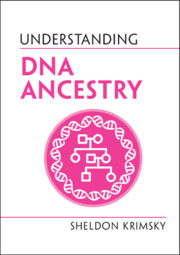Book contents
- Understanding DNA Ancestry
- Series page
- Understanding DNA Ancestry
- Copyright page
- Reviews
- Dedication
- Contents
- Foreword
- Acknowledgments
- 1 Introduction
- 2 The Business of DNA Ancestry
- 3 What Our Genomes Tell Us about the Geographical Origins and Movements of Early Human Populations
- 4 The Science behind DNA Ancestry Testing
- 5 Ancestry Informative Markers
- 6 Ancestry DNA Population Reference Panels
- 7 Comparing a Donor’s DNA to Reference Panel Populations
- 8 Probing Your DNA
- 9 Forensic Applications of Ancestry DNA Results
- 10 Privacy, Personal Identity, and Legal Issues
- 11 Discovering Unknown, Missing, or Mistaken Relatives
- 12 Accuracy, Consistency, and Validation of DNA Ancestry Tests
- 13 Conclusion
- Summary of Common Misunderstandings
- References
- Index
- Other books authored, coauthored, or coedited by Sheldon Krimsky
11 - Discovering Unknown, Missing, or Mistaken Relatives
Published online by Cambridge University Press: 05 March 2022
- Understanding DNA Ancestry
- Series page
- Understanding DNA Ancestry
- Copyright page
- Reviews
- Dedication
- Contents
- Foreword
- Acknowledgments
- 1 Introduction
- 2 The Business of DNA Ancestry
- 3 What Our Genomes Tell Us about the Geographical Origins and Movements of Early Human Populations
- 4 The Science behind DNA Ancestry Testing
- 5 Ancestry Informative Markers
- 6 Ancestry DNA Population Reference Panels
- 7 Comparing a Donor’s DNA to Reference Panel Populations
- 8 Probing Your DNA
- 9 Forensic Applications of Ancestry DNA Results
- 10 Privacy, Personal Identity, and Legal Issues
- 11 Discovering Unknown, Missing, or Mistaken Relatives
- 12 Accuracy, Consistency, and Validation of DNA Ancestry Tests
- 13 Conclusion
- Summary of Common Misunderstandings
- References
- Index
- Other books authored, coauthored, or coedited by Sheldon Krimsky
Summary
Much of recreational DNA ancestry offers consumers a long reach into the history of their descent by discovering which biogeographical population most closely matches their DNA profiles. The science and DNA analytics provide probability estimates that their DNA markers (ancestry informative markers, or AIMs) are most likely from a particular continent or even a specific country. But DNA ancestry tests have applications that go well beyond recreational genealogy. Even prior to the growth of this sector of direct-to-consumer testing, DNA was used to determine paternity and to establish identity in criminal investigations. An important and largely unintended application of ancestry DNA testing has been the uncovering of family secrets: “Why does my father look so different from his parents?” or “Why are my mother’s skin tones so much darker than those of her parents?”
Keywords
- Type
- Chapter
- Information
- Understanding DNA Ancestry , pp. 106 - 117Publisher: Cambridge University PressPrint publication year: 2021

